As Google continues to update its algorithm to provide searchers with the best user experience possible, SEO professionals must also update their techniques to stay competitive.
If you’re just getting started, you’ll want to work your way through SEO for Beginners: An Introduction to SEO Basics first.
Then, with the basics well in hand, you can move on to more advanced SEO tips and techniques to really move the needle.
Here are 10 you’ll definitely want to know.
1. Prioritize Your Mobile Site For Mobile-First Indexing
Hopefully, you’ve been keeping up with Google’s migration to mobile-first indexing.
And hopefully, you’ve also been steering clear of the many, many misconceptions about what mobile-first indexing means and how it will affect ranking.
Let’s be clear: when it comes to mobile-first indexing, you do not need a flawless mobile site to claim your spot as king of the hill (or the SERPs).
And you certainly should not abandon SEO for your desktop site just because mobile-first indexing is here.
Here’s what you need to remember when it comes to this change:
Mobile-first indexing is here.
That means that if you have a desktop and a mobile version of your site, the mobile version will be indexed and ranked preferentially to your desktop version. If that hasn’t happened to you yet, it will soon. There’s no way to “opt out.”
There’s never been a better time to build a responsive site.
If you know your audience uses mobile then it’s time to take the leap!
Do not use intrusive interstitials.
Just don’t. They’re not user-friendly, and even if Google isn’t cracking down hard on them yet, that change may soon come.
Create content with mobile in mind (without sacrificing value).
That means avoiding any formats that have trouble loading on mobile devices and preserving all the content from your desktop site that helps it rank (shorter mobile sites might be nicer aesthetically but they often won’t rank as well).
Create a responsive site.
If your site hasn’t migrated yet and you’ve been thinking about going responsive, it’s the best moment to do it.
Make good use of “overwhelm-proof” methods.
Hamburger and accordion menus won’t hamper indexing and they’ll often improve user experience (especially on mobile devices).
Remember, the fewer obstacles your mobile site has for Googlebot, the better.
Just to be safe, you should regularly check your server log files for crawling errors.
2. Optimize For Speed
Mobile page speed is a ranking factor.
But how does that actually affect the SEO industry?
To find out, my team conducted an experiment both before and after the infamous Page Speed Update to understand what factors influence real Google rankings.
The findings showed that page speed really doesn’t influence rankings very much at all — but the optimization level does.
You can check both your page speed and your website optimization using PageSpeed Insights tool.
This tool now measures sites according to both:
- Optimization quality (“lab data” backed by the Lighthouse tool).
- Loading time of real users (“field data” derived from real user metrics of Chrome users taken from CrUX report data).
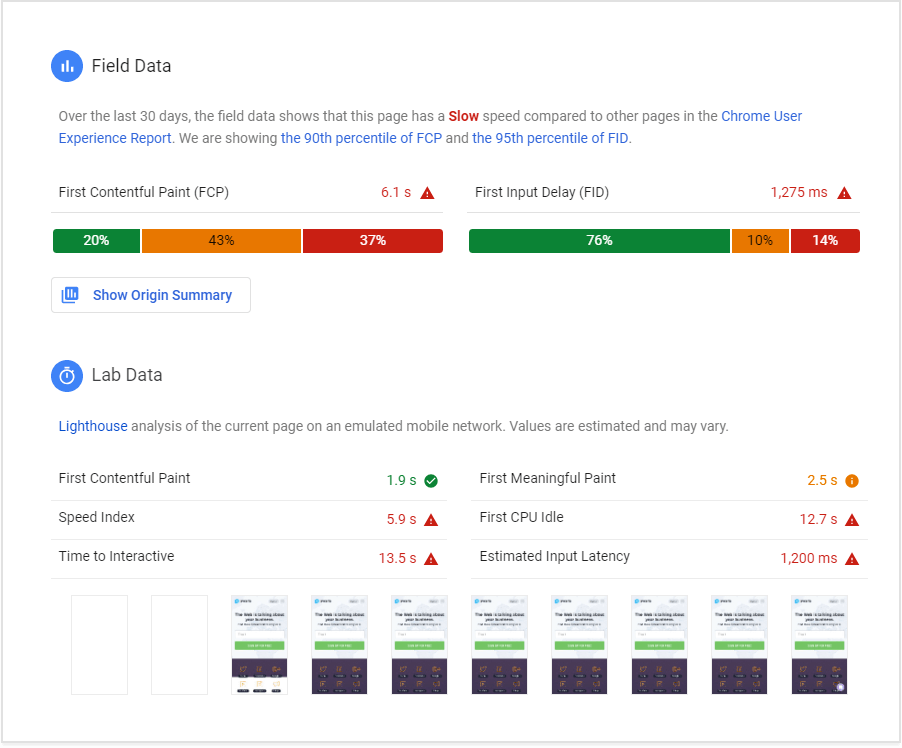 Screenshot by Author, November 2021
Screenshot by Author, November 2021I’m sure Google is vigorously testing all the factors, and we will see a lot of changes quite soon.
For the time being, make sure your site is being vigorously optimized:
- Run regular technical site audits and fix problems.
- Follow Google’s recommendations for possible optimizations. You can get those right in the PageSpeed Insights tool.
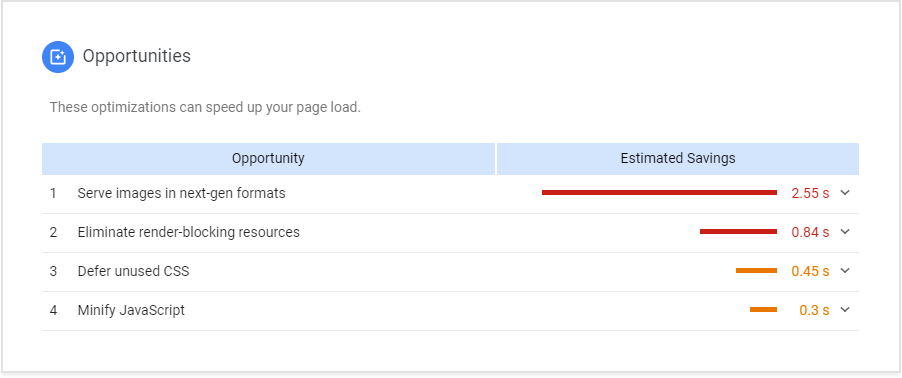 Screenshot by Author, November 2021
Screenshot by Author, November 20213. Leverage Google’s CrUX Report
The Google Chrome User Experience Report provides real world user experience metrics, gathering data as people browse popular websites. Data is available via the PageSpeed Insights, the Public Google BigQuery project, and the CrUX Dashboard on Data Studio.
While it’s not playing a major role in SERPs yet, I wouldn’t be surprised to see Google lean more heavily on this “field data” instead of “lab data.”
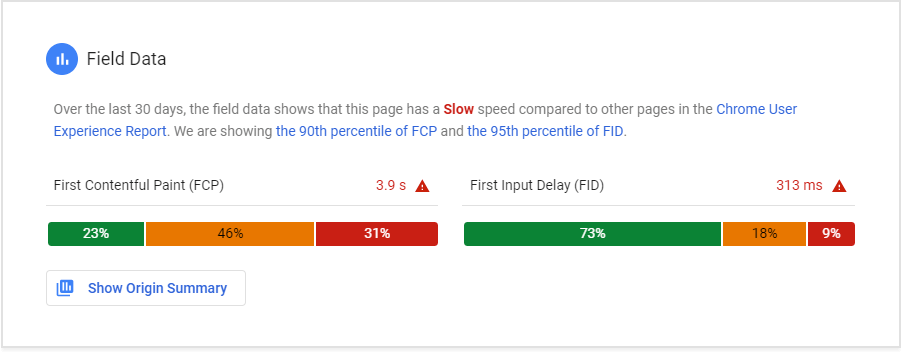 Screenshot by Author, November 2021
Screenshot by Author, November 2021What makes this data challenging for SEO professionals is that if we do see the industry shift towards RUMs, it’s nearly impossible to use local tests to uncover this data — which makes it challenging to optimize for.
The good news, however, is that the CrUX report is publicly available, and you can explore all the data needed: device and connection type, loading time of this or that page, etc.
All you need is a project in the Google Cloud Platform where you have an access to the CrUX public project page.
With some basic knowledge of SQL, you can get the raw data collected by Google for your site and change your strategy based on this information:
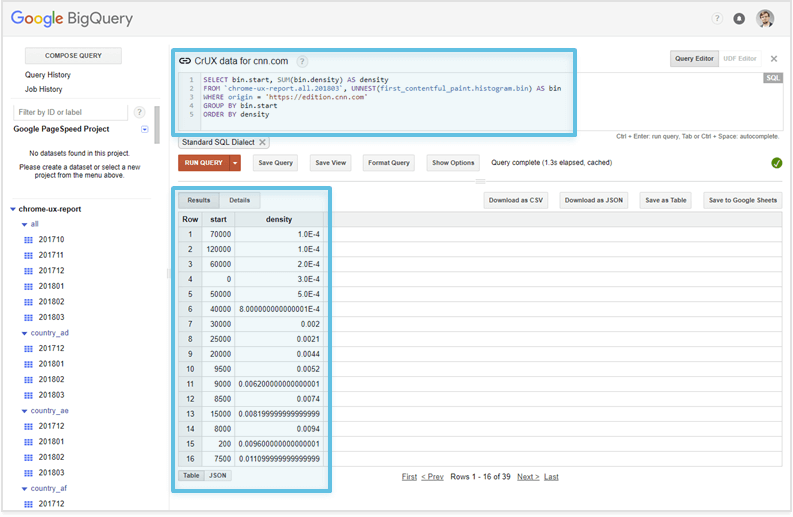 Screenshot by Author, November 2021
Screenshot by Author, November 20214. Get More SERP Space
Google’s front page has undergone so many facelifts over the years, so who knows what the future holds for SERP staples like local packs, ads, knowledge panels, answer boxes, and so on.
The only thing we can bank on is that organic search results are constantly changing.
For example, the Hotel Pack has recently changed quite a lot, acquiring a different filtering system and four results instead of three:
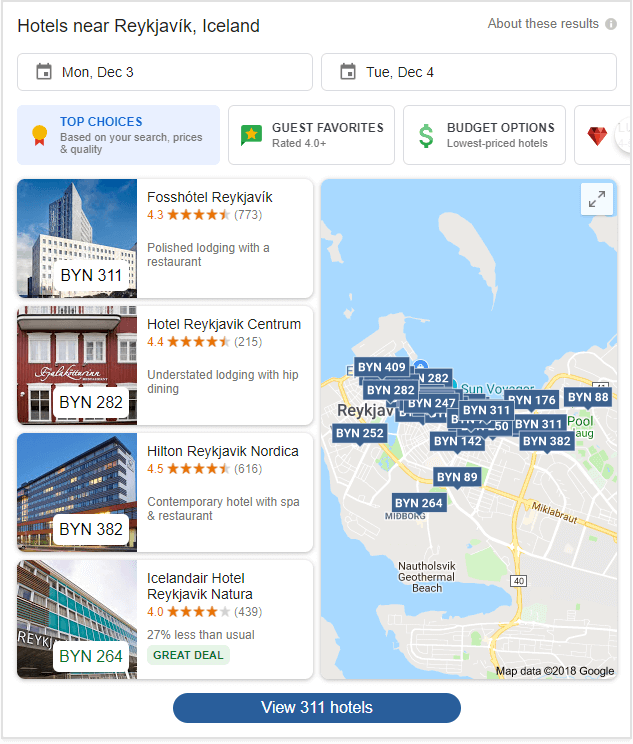 Screenshot by Author, November 2021
Screenshot by Author, November 2021So how do you secure a foothold in this tumultuous search landscape?
Here’s where you start:
Land Featured Snippets
I know featured snippets have been out there for quite a while but they haven’t diminished in value.
Featured snippets are still featured above search results (and, unfortunately, they’re still hard to get and even harder to keep long-term).
So how do you get a featured snippet?
- You create content with ranking keywords around questions (questions you know your audience wants answered).
- You format your content snippet-wise (in paragraphs, tables, lists, etc.)
It’s also worth checking out this Stone Temple study which found that different formatting techniques have different success rates depending on the market:
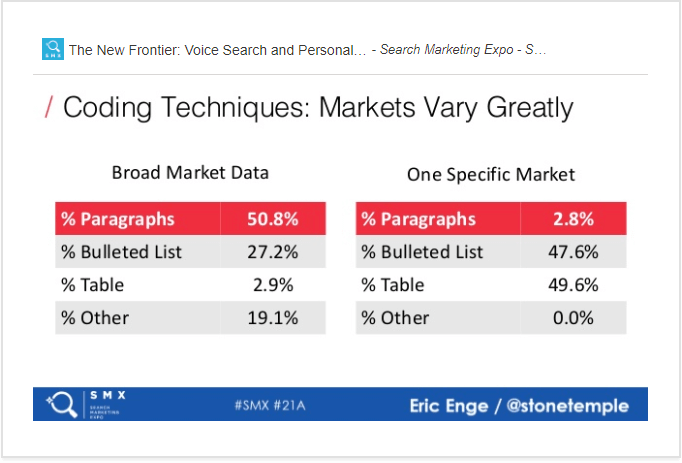 Screenshot by Author, November 2021
Screenshot by Author, November 2021Answer FAQs on hot topics in your niche using small paragraphs of text (40-60 words — the size of a regular featured snippet).
While it isn’t a guaranteed ticket to position zero, it seems to work really well for different kinds of definitions (just watch out for answer boxes on queries that provide actual dictionary definitions).
Use Schema
While schema markup won’t get you a featured snippet, it can get you one (or more) SERP features.
Here, besides the actual schema implementation, go to Google and experiment with the queries you’d like to rank for.
- Study which SERP types are pulled with these queries.
- Find out which spaces are occupied with your content and ask yourself whether you’re satisfied with what they feature.
- Also (and perhaps most importantly), look for the gaps your content can fill in.
5. Think Of Videos As The Content King
Video may have killed the radio star and now it looks like it’s eyeing the written word as its next victim.
That’s a joke — please don’t stop writing content entirely!
However, we have learned:
- People watch billions of videos on YouTube every single day.
- YouTube is the 2nd largest search engine.
- 96% of consumers increased their time watching online videos since 2020.
And, lest we forget, videos are a phenomenal way to boost engagement.
Here’s the best place to start making and optimizing videos for your audience:
- Make short brand videos and product demos.
- Create educational videos on how to use your products or services.
- Run live broadcasts like webinars or interviews.
- Add relevant metadata (shorter titles, rich descriptions) and transcripts for videos for Google to fully understand their intent(s).
- Go for exact keyword matching (this is still a thing on YouTube).
- Fill in keyword tags, as they are used for recommended videos.
- Upload videos to different popular platforms: YouTube, Wistia, Facebook, Vimeo, Instagram, etc.
- Submit a video sitemap to search engines.
Also, remember that the demand for how-to videos on YouTube is growing by 70 percent each year.
6. Update Your Google My Business Listing
Google adds features to its Google My Business (GMB) like crazy in pursuit of developing local search.
According to Google, GMB can impact your rankings in local search results.
Components like Google Posts, images, Google Q&A, and reviews are considered some of the main GMB ranking factors.
Despite that, few businesses bother optimizing for GMB signals, so it’s an opportunity that may give you a leg up over your competitors.
Here are a few tips and tricks to consider:
Use Google Posts
I’m sure you publish on Facebook and Twitter. Do the same for Google Posts.
Remember to use engaging calls to action to spark conversations.
Add Your Own Questions & Answers to Google Q&A
This way, this section will have branded content that ties back to your business.
Upload & Regularly Update Images in Your GMB Listing
And remember, you can now add videos there too!
Fill in All the Categories in Your Listing
GMB is being constantly updated with new categories.
If you haven’t logged in to your profile for a while, you may be surprised to find out a number of empty fields.
Make sure to regularly update your profile info as well.
Leverage Reviews
Reviews have always been an important factor for business reputation and relevance, and that isn’t changing anytime soon.
Ask every customer to write a review mentioning a specific service or product they liked and always reply to them.
7. Qualify Outbound Links
Do you have outbound links within your website’s user-generated content, such as blog comments or forum posts?
Does your website offer sponsored link opportunities to generate advertising revenue?
If you have any links on your web pages that you would prefer Google not associate with your domain, you can go beyond the rel=“nofollow” attribute. Google allows you to qualify your outbound links with the following.
- Use rel=“sponsored” for paid links used for generating advertising income.
- Use rel=“ugc” for links contained within user-generated content including blog comments, forum posts, reviews, etc.
8. Learn How To Use Google Search Console
Google Search Console continues to add lots of helpful features, making it one of the most essential SEO tools on the market.
Even if you prefer other tools, it’s worth a look.
Here are some of the most useful features:
URL Inspection
Test links in real-time and scope out any problems Google detects. Once they are fixed, it’s possible to validate them right in this tool and ask for a recrawl.
Index Coverage Report
This report divides all URLs into four buckets – Errors, Valid, Valid With Warnings, and Excluded – and gives reasons why those statuses have been attached and ways to fix problems.
Performance Report
More-or-less the same old Search Analytics report you’re used to but it now has a significantly expanded date range — 16 months instead of 3.
Reports Share Function
This lets GSC users share their reports with anyone, even if they don’t have an account. It comes in handy when you need to share some reports with your developers, for example.
Reports Filters
These got much more sophisticated. Now they feel like Excel.
9. List Your Products On Amazon (Especially If You’re B2C)
Amazon is basically the Google of ecommerce.
So, if you sell something and you are still not on Amazon, think how you miss all those 56% of customers going past Google search.
If you are ready to take this opportunity, mind that Amazon uses its own search algorithm known as A9.
Here are the principal differences between Google and Amazon algorithms:
| Google search algorithm | vs. | Amazon search algorithm |
| Pursues a higher research intent (i.e., tries to answer the user’s question) | Pursues a higher purchase intent (i.e., tries to sell a product) | |
| Defines relevancy by engagement behavior (CTR, bounce rates, dwell time, etc.) | Defines relevancy by purchase behavior (conversions after the search) |
When optimizing for the Amazon algorithm, remember:
- Sales velocity is considered to be a key factor.
- Paid ads are a must-have if you want users to find you.
- Create great content to make users convert (use images, unique descriptions, reviews, promos, etc.).
10. Employ Creative Link Building
Link building is still alive and kicking.
It may not bring the fast onslaught of results a hot Black Friday ad will but cultivating a healthy network of traditional links is still one of the most reliable methods of building long-term, sustainable growth for your business.
That said, sometimes creative link building can put you on the fast track for success.
Methods such as coining a phrase that becomes a staple in your niche can quickly take off and earn you some valuable link equity.
For example, a couple of years ago, nobody had heard of “position zero.” Now a quick Google search turns up almost 1 billion unique results for that key phrase.
Another link building method is to get links from the sites that use your visual content without a reference.
If you have created some useful visual assets like infographics, for example, search Google for this image. Most likely, you will see a number of sites that were happy to find and use your infographics.
Now you can contact them and ask for a reference to your site as an image source.
Voila! Free links!
You can also win links from your speaking events.
You’ll get a link from the event itself. But you can also share the event on social media and angle for some likes and shares on other platforms.
You will also (hopefully) earn links after your event, as people blog and retweet your speech insights.
Milk your 15 minutes of fame for all the links you can get!
These are just a few creative ways you can earn links that gain traction quickly but rest assured there are many more out there (and many just waiting to be discovered by someone like you).
Final Thoughts
I’m looking forward to next year. I think it’s going to be an even bigger year for video content and micro-influencers, and we’re going to see the rise of social listening as more important than ever before.
But whatever the future holds, don’t forget about the basics. Tried-and-true SEO methods are far from obsolete, so don’t neglect industry best practices in your pursuit of the latest SEO fad.
At the same time, don’t be afraid to approach problems from a new and unique angle — who knows, maybe you’ll be the one setting the SEO trends of 2022!
More Resources:
- A Complete Guide to SEO: What You Need to Know in 2019
- Top 8 Essential Website Optimization Strategies for 2019
- How to Get Your SEO Keyword Strategy Right: Basic & Advanced Tips
Featured image: Shutterstock/Vektor Illustration




